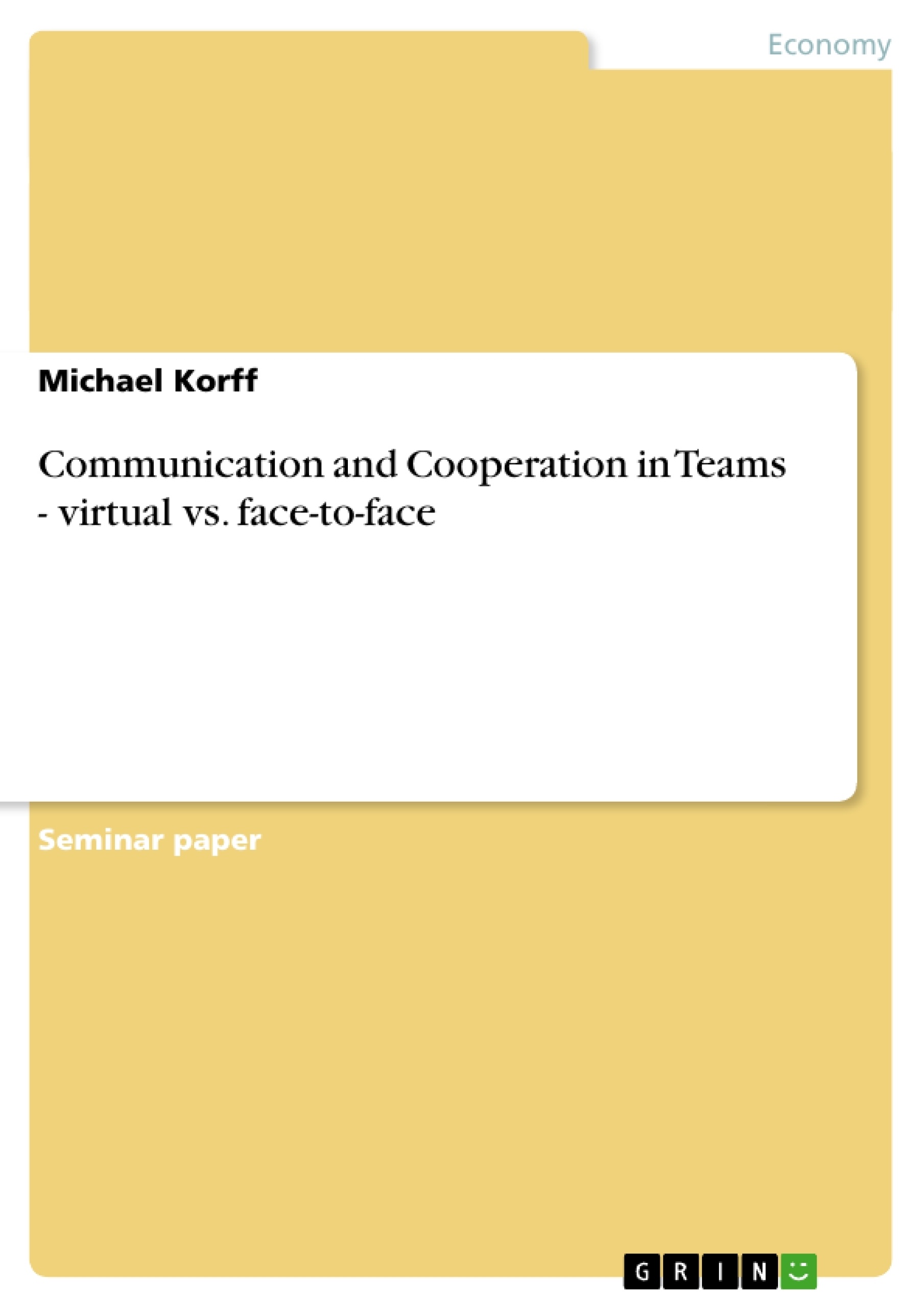Excerpt
Table of contents
1. Introduction
2. Aspects of teamwork
2.1 Team
2.2 Special requirements on virtual team members
2.3 Communication
2.4 Leadership
2.5 Knowledge Transfer
3 Summary
table of figures
Figure 1: Processes in virtual teams 8
Figure 2: Basic Model of Communication
Figure 3: Media-Richness-Modell 10
Figure 4: Extended Communication Model
Figure 5: Comparison of direct and indirect Knowledge Transfer 21
Figure 6: In welcher Art von Team ist ... problematischer 29
1. Introduction
The growing significance of computer and internet as a work and communication medium can observe increasing tendencies of decentralization, mobilization and mechanization of our work. That means the interest in virtual cooperation rises strongly in many enterprises.
This kind of labour organization offers the possibility of concentrating the knowledge of different co-workers and/or external specialists also over long distances (over countries or even continental borders) in a team. However, the unification of specialist and expert knowledge is made possible by the use of suitable information and communication technologies only. With these aids this knowledge is (apparently) callable without any larger temporal delay. That brings substantial cost advantages by a shortened achievement completion and decreased travel times and costs and makes a contribution in such a way through cost optimization to the receipt and for the increase of competitive ability.
In order to be able to ensure efficient working in virtual teams at all a set of basic conditions must be considered. Substantial factors apart organization of work and used instruments are humans involved in that process, especially their communication and cooperation behaviour.
This essay will briefly examine what kind of differences in communication and cooperation exist between a virtual and a conventional (face-to-face) team.
2. Aspects of teamwork
2.1 Team
"A team is a group of human beings, working together permanently or on time, goal and job oriented and in mutual dependence to achieve a result which exceeds (or shall exceed) the sum of the individual performances. By developing an inner social structure norms and values are shared, responsibility is taken over together and mutually. Connected to that is the idea of a high cohesion and a functioning cooperation of the team members." 1
According to Lipnack and Stamps a virtual team is - like any other team – a group of humans interacting through interdependent tasks and linked to a common purpose. No doubt, it is a real team, no electronic substitute. 2
Consequently the demands are all the same for 'real' teams as well for virtual teams. Nevertheless, they act in another kind of existence: the virtual or digital reality. In contrast to conventional teams, a virtual team works without boundaries of space, time and organisation and uses networks enabled by communication technologies. 3 In other words: virtual teams are faced with the challenges of 'teamwork itself' as well as the challenges of virtual working. 4 This means every member of the team must have additional capabilities to reach good results in virtual arrays additional to the well-known abilities to work in a team we need not to mention it here again.
What about the differences? The discussion of the actual literature on this topic, according to a summary of Tea & Bal, two scientific co-workers of the University of Warwick, England, refers to five authors 5 who discussed this in detail. There are essential differences
- at special requirements on virtual team members
- in communication
- in leadership
- in knowledge transfer.
This is also one of the core statements of Meier, C. et al. who says that communication and cooperation represent central links in [virtual] structures; above these there will be constituted affiliation, loyalty, achievement processes and problem solutions and at least the team, the network or the enterprise itself. 6
2.2 Special requirements on virtual team members
The members of spatially distributed project teams, of networks and virtual enterprises are faced with a new situation, when central processes such as the coordination of work activities, conflict management, leadership or knowledge transfer, too must be done medium-based or medium-filtered. 7
illustration not visible in this excerpt
Figure 1: Processes in virtual teams 8
According to Figure 1, the team communicates by the so called 'new media'. Thus the individual team member must possess enhanced medium competence. This presupposes the capability to use different media in an adequate, coordinated and goal-oriented way. It includes technical, social and organizational aspects and also the capability of using and targeting media for a special team situation as well as the allocation of the media itself. 9
2.3 Communication
If we talk about cooperation of team members, communication will be the main topic. This is valid for virtual teams and for conventional (face to face) teams, too. The transfer of messages can be described in a simplified model as shown in Figure 2.
illustration not visible in this excerpt
Figure 2: Basic Model of Communication
But this model neglects important personal and social magnitudes of influence. The systematically comprehension of communication (Watzlawick et al.) is a valuable supplement. Especially circular processes and moments of feedback in communication processes are emphasized. In short form one of the five postulated axioms means: communication = content + aspect of relationship or metacommunication.
[...]
- Quote paper
- Dipl.Verwaltungswirt (FH) Michael Korff (Author), 2005, Communication and Cooperation in Teams - virtual vs. face-to-face, Munich, GRIN Verlag, https://www.grin.com/document/67063
Publish now - it's free






















Comments